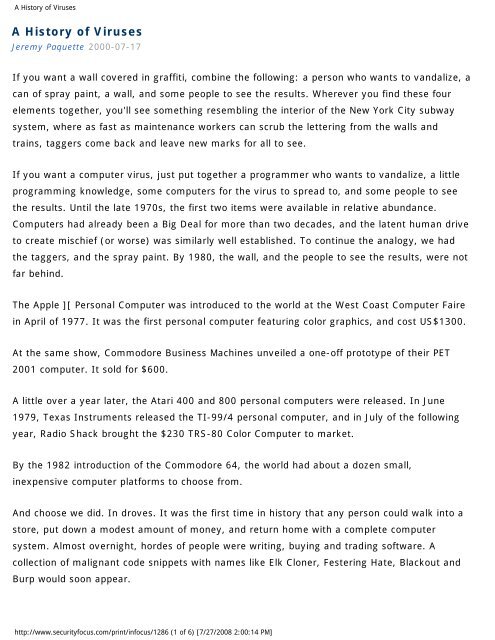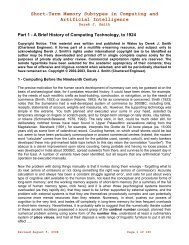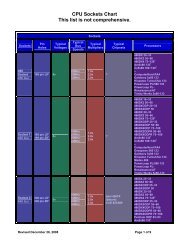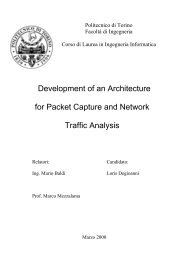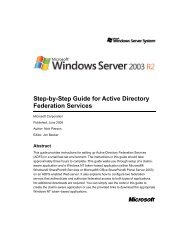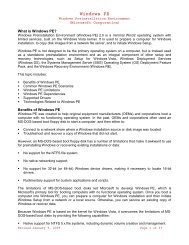A History of Viruses.pdf - Bandwidthco Computer Security
A History of Viruses.pdf - Bandwidthco Computer Security
A History of Viruses.pdf - Bandwidthco Computer Security
Create successful ePaper yourself
Turn your PDF publications into a flip-book with our unique Google optimized e-Paper software.
A <strong>History</strong> <strong>of</strong> <strong>Viruses</strong><br />
A <strong>History</strong> <strong>of</strong> <strong>Viruses</strong><br />
Jeremy Paquette 2000-07-17<br />
If you want a wall covered in graffiti, combine the following: a person who wants to vandalize, a<br />
can <strong>of</strong> spray paint, a wall, and some people to see the results. Wherever you find these four<br />
elements together, you'll see something resembling the interior <strong>of</strong> the New York City subway<br />
system, where as fast as maintenance workers can scrub the lettering from the walls and<br />
trains, taggers come back and leave new marks for all to see.<br />
If you want a computer virus, just put together a programmer who wants to vandalize, a little<br />
programming knowledge, some computers for the virus to spread to, and some people to see<br />
the results. Until the late 1970s, the first two items were available in relative abundance.<br />
<strong>Computer</strong>s had already been a Big Deal for more than two decades, and the latent human drive<br />
to create mischief (or worse) was similarly well established. To continue the analogy, we had<br />
the taggers, and the spray paint. By 1980, the wall, and the people to see the results, were not<br />
far behind.<br />
The Apple ][ Personal <strong>Computer</strong> was introduced to the world at the West Coast <strong>Computer</strong> Faire<br />
in April <strong>of</strong> 1977. It was the first personal computer featuring color graphics, and cost US$1300.<br />
At the same show, Commodore Business Machines unveiled a one-<strong>of</strong>f prototype <strong>of</strong> their PET<br />
2001 computer. It sold for $600.<br />
A little over a year later, the Atari 400 and 800 personal computers were released. In June<br />
1979, Texas Instruments released the TI-99/4 personal computer, and in July <strong>of</strong> the following<br />
year, Radio Shack brought the $230 TRS-80 Color <strong>Computer</strong> to market.<br />
By the 1982 introduction <strong>of</strong> the Commodore 64, the world had about a dozen small,<br />
inexpensive computer platforms to choose from.<br />
And choose we did. In droves. It was the first time in history that any person could walk into a<br />
store, put down a modest amount <strong>of</strong> money, and return home with a complete computer<br />
system. Almost overnight, hordes <strong>of</strong> people were writing, buying and trading s<strong>of</strong>tware. A<br />
collection <strong>of</strong> malignant code snippets with names like Elk Cloner, Festering Hate, Blackout and<br />
Burp would soon appear.<br />
http://www.securityfocus.com/print/infocus/1286 (1 <strong>of</strong> 6) [7/27/2008 2:00:14 PM]
A <strong>History</strong> <strong>of</strong> <strong>Viruses</strong><br />
In 1982, a junior high school student named Richard Skrenta had recently been given his first<br />
computer for Christmas - an Apple ][. Recalls Skrenta, "I had always been mechanically<br />
curious, taking apart tube radios and telephones and wiring up O gauge Lionel train sets when I<br />
was young. When I got an Apple II in the 7th grade, I was in heaven.<br />
"I had been playing jokes on schoolmates by altering copies <strong>of</strong> pirated games to self-destruct<br />
after a number <strong>of</strong> plays. I'd give out a new game, they'd get hooked, but then the game would<br />
stop working with a snickering comment from me on the screen (9th grade humor at work<br />
here)".<br />
Soon, classmates were getting wary <strong>of</strong> letting Skrenta near their disks. He needed a way to<br />
alter their floppies to contain his "booby traps" without physically being able to get his hands on<br />
them. "I hit on the idea to leave a residue in the operating system <strong>of</strong> the school's Apple II. The<br />
next user who came by, if they didn't do a clean reboot with their own disk, could then be<br />
touched by the code I left behind. I realized that a self-propagating program could be written,<br />
but rather than blowing up quickly, to the extent that it laid low it could spread beyond the first<br />
person to others as well. I coded up Elk Cloner and gave it a good start in life by infecting<br />
everyone's disks I could get my hands on."<br />
Skrenta's choice <strong>of</strong> platform is perhaps the only reason why Elk Cloner is not <strong>of</strong>ten seen "in the<br />
wild" today - in the history <strong>of</strong> viruses, non-PC-based malware has never flourished as widely as<br />
those written for IBM-compatible systems.<br />
In 1986, the most common microcomputer in the world was the IBM PC. Basit Farooq Alvi and<br />
Amjad Farooq Alvi were running a computer store in Lahore, Pakistan. The name <strong>of</strong> their store<br />
was Brain <strong>Computer</strong> Services. Recently, it had occurred to Basit and Amjad that the start <strong>of</strong> a<br />
floppy disk contained program instructions which the computer executes on startup. Like so<br />
many programmers after them, they elected to alter these instructions to their own ends.<br />
To this day, their exact motives are pure speculation, though some believe it was to create a<br />
virus which would inhibit American s<strong>of</strong>tware piracy. Whatever their reason, they intended to<br />
create a program which would spread from PC to PC. In accomplishing this goal, they created<br />
the (c)Brain virus.<br />
In 1987, users at the University <strong>of</strong> Delaware started seeing the "(c)Brain" label on diskettes.<br />
Luckily, this was the extent <strong>of</strong> (c)Brain's repertoire. It copied itself, and overwrote the diskette's<br />
http://www.securityfocus.com/print/infocus/1286 (2 <strong>of</strong> 6) [7/27/2008 2:00:14 PM]
A <strong>History</strong> <strong>of</strong> <strong>Viruses</strong><br />
volume label with the name <strong>of</strong> the virus.<br />
Like Elk, Brain was pretty benign, as computer viruses go. It doesn't delete your files. It<br />
replicates and moves on. Again, being harmless is a good strategy for a virus - for biological<br />
ones as well as malware. Compare your chances <strong>of</strong> catching the common cold to, say,<br />
Hantavirus. The more damage the pathogen does, the more it gets noticed. With a little self-<br />
restraint, a virus like (c)Brain can survive in the wild for a long, long time. The volume label<br />
behavior has been changed in subsequent programmer-induced "mutations" <strong>of</strong> (c)Brain. Most<br />
likely, this is because it's too easy for an "infected" user to discover the presence <strong>of</strong> the virus<br />
merely by simply noticing the changed volume label.<br />
Other viruses soon followed (c)Brain. Among them were Alameda (Yale), Cascade, Jerusalem,<br />
Lehigh and Miami (South African Friday the 13th). These viruses exhibited some new tricks:<br />
while (c)Brain infected the boot sector, the new guys were able to infect .COM and .EXE files.<br />
As well as looking for new targets <strong>of</strong> infection, virus programmers were starting to hide their<br />
work. Cascade was the first encrypted virus - a technique meant to deter disassembly and<br />
detection <strong>of</strong> the virus' program code.<br />
Variable encryption made its debut in 1989 with the "1260" virus. This now meant that<br />
scanning for fixed strings common to all copies <strong>of</strong> a given virus would be less effective, as the<br />
majority <strong>of</strong> the virus' code appeared in a different form with each successive infection.<br />
The same year, the first stealth techniques emerged. These viruses could change or conceal<br />
their location in memory, actively avoiding detection and removal by anti-virus tools.<br />
The Whale virus took this even further - it could rewrite its own instructions in such a way that<br />
it never consistently looks the same way twice. This marked the beginning <strong>of</strong> the end for string<br />
scanning and other techniques which relied on fixed, predictable elements appearing in each<br />
copy <strong>of</strong> a virus. As it happens, Whale was not particularly talented - it has been described as<br />
"too clumsy to work". Even still, its size and new, complex behavior made it famous.<br />
Until this time, two classes <strong>of</strong> wild PC viruses had been reported. File infectors, which append<br />
themselves to executable programs, and boot sector viruses, which take advantage <strong>of</strong> the<br />
special segment <strong>of</strong> executable code at the beginning <strong>of</strong> a floppy or hard disk which is executed<br />
by the PC on startup.<br />
http://www.securityfocus.com/print/infocus/1286 (3 <strong>of</strong> 6) [7/27/2008 2:00:14 PM]
A <strong>History</strong> <strong>of</strong> <strong>Viruses</strong><br />
By 1992, the prevalence <strong>of</strong> Windows had led to a shift in these numbers. While boot sector<br />
infectors coexisted peacefully with Windows 3.1, file infectors tailored to the DOS environment<br />
frequently crashed their hosts before they had a chance to spread effectively.<br />
As a result, the inception <strong>of</strong> a large Windows-based computing community led to a decline in<br />
wild sightings <strong>of</strong> infector viruses, while the incidence rate for boot-sector infectors continued to<br />
increase.<br />
As well as encouraging the decline <strong>of</strong> file infectors, the new, feature-rich Windows platform<br />
created a niche for a distinct category <strong>of</strong> malware: the macro virus.<br />
A macro is a collection <strong>of</strong> user commands which can be stored and run as a group. Usually,<br />
macros are meant for automating repetitive tasks within a particular application (ie, search for<br />
instances <strong>of</strong> the word "abc" and replace with "xyz".) In the case <strong>of</strong> a macro virus, this language<br />
is used to create the routines which allow the macro virus' instructions to spread to and infect<br />
other documents.<br />
The first reported macro virus, "Concept", was seen in the wild by AV researcher Sarah Gordon<br />
in summertime <strong>of</strong> 1995. A set <strong>of</strong> five macros designed only to replicate, Concept's payload<br />
displays the virus author's ominous message: "That's enough to prove my point".<br />
These viruses exploited a new channel between users: document sharing. Until the inception <strong>of</strong><br />
macro viruses, users could only spread viral infections via bootable diskettes or infected<br />
programs. By infecting data files, Concept and its descendents were able to leverage the fact<br />
that most users tend to exchange documents much more prolifically than they exchange<br />
programs.<br />
In late July, 1996, Gordon received a wild copy <strong>of</strong> another macro virus, this time for MS Excel.<br />
Dubbed "XM.Laroux", it exploited the same type <strong>of</strong> macro language in which Concept was<br />
written, but it worked in MS Word's number-crunching cousin. Now spreadsheets, too, could<br />
contain harmful malware.<br />
Again, the increasing tendency <strong>of</strong> users to exchange documents as part <strong>of</strong> their everyday work<br />
allowed this virus to spread. Moreover, by exploiting the emerging trend toward<br />
interoperability, the macro virus broke down the barriers between different computing<br />
platforms. A macro virus infecting a Micros<strong>of</strong>t Word or Excel document on a PC could now<br />
http://www.securityfocus.com/print/infocus/1286 (4 <strong>of</strong> 6) [7/27/2008 2:00:14 PM]
A <strong>History</strong> <strong>of</strong> <strong>Viruses</strong><br />
spread to a Macintosh, or any other computer for which the application was available.<br />
An excerpt from the source code <strong>of</strong> Melissa says it all:<br />
"WORD/Melissa written by Kwyjibo<br />
Works in both Word 2000 and Word 97<br />
Worm? Macro Virus? Word 97 Virus? Word 2000 Virus? You Decide!<br />
Word -> Email | Word 97 Word 2000 ... it's a new age! "<br />
"A new age" is right. We've already come a long way from the Elk Cloner virus, which infected<br />
only one type <strong>of</strong> file (the boot sector) on one particular operating system (Apple DOS). Several<br />
developments would converge to increase the scope <strong>of</strong> the modern virus threat still further.<br />
Micros<strong>of</strong>t answered customer requests for more flexible, automation-friendly features with the<br />
1997 introduction <strong>of</strong> the Windows Scripting Host. This technology gave different Windows<br />
applications a common programming language (VBScript), allowing new features to be added to<br />
applications as required. Unfortunately, it is also possible to use this language to write highly<br />
viable malware.<br />
At the same time, greater connectivity between users (through the growing Internet and<br />
corporate networks) increased the widespread sharing <strong>of</strong> documents or spreadsheets as e-mail<br />
attachments. If an attachment was actually a Visual Basic script, concealed as a document, the<br />
Windows Scripting Host would still execute it in much the same way that Word or Excel would<br />
run a macro.<br />
Micros<strong>of</strong>t's own comment says it best: "It's important to note that the virus payload cannot run<br />
by itself. In order for it to run, the recipient must open the mail, launch the payload by double-<br />
clicking on it, and answer 'yes' to a dialogue that warns <strong>of</strong> the dangers <strong>of</strong> running untrusted<br />
programs."<br />
Surprisingly, when the "Love Bug" hit, many, many thousands <strong>of</strong> people did just that, accepting<br />
an attachment called "Love Letter" at face value. Within four hours <strong>of</strong> its release into the wild,<br />
VBS.LoveLetter was the most successful virus <strong>of</strong> all time. by May, 2000, roughly thirty variants<br />
<strong>of</strong> the virus had been identified.<br />
Dozens <strong>of</strong> new viruses have made their debut since the Melissa and I.Love.You incidents. These<br />
descendants <strong>of</strong> the recent macro and VBScript threats have earned headlines <strong>of</strong> their own, and<br />
http://www.securityfocus.com/print/infocus/1286 (5 <strong>of</strong> 6) [7/27/2008 2:00:14 PM]
A <strong>History</strong> <strong>of</strong> <strong>Viruses</strong><br />
despite the wide release <strong>of</strong> s<strong>of</strong>tware patches and instructions for avoiding these threats, users<br />
are still reporting infections by the hundreds. Given that the most prevalent virus on record<br />
spreads only with the "permission" <strong>of</strong> each infected user, it seems that human factors are<br />
beginning to outweigh technical ones as the primary genesis <strong>of</strong> viral security threats. The<br />
problem <strong>of</strong> teaching the user population to practice safe computing is a challenge at least equal<br />
to the technical question <strong>of</strong> making computers safe from malicious code.<br />
Clearly, it's anyone's guess what the next virus threat will look like. But no matter how the next<br />
chapter in virus history may unfold, it will always come down to the malicious programmer and<br />
his desire for an audience.<br />
Relevant Links<br />
Guidelines for an Anti-Virus Policy<br />
Dr. Solomon's<br />
Virus Glossary<br />
McAfee<br />
Worms<br />
Dr. Solomon's<br />
Who Writes This Stuff?<br />
Sarah Gordon<br />
Virus naming conventions<br />
Micros<strong>of</strong>t on VBS/Loveletter<br />
Privacy Statement<br />
Copyright 2006, <strong>Security</strong>Focus<br />
http://www.securityfocus.com/print/infocus/1286 (6 <strong>of</strong> 6) [7/27/2008 2:00:14 PM]


